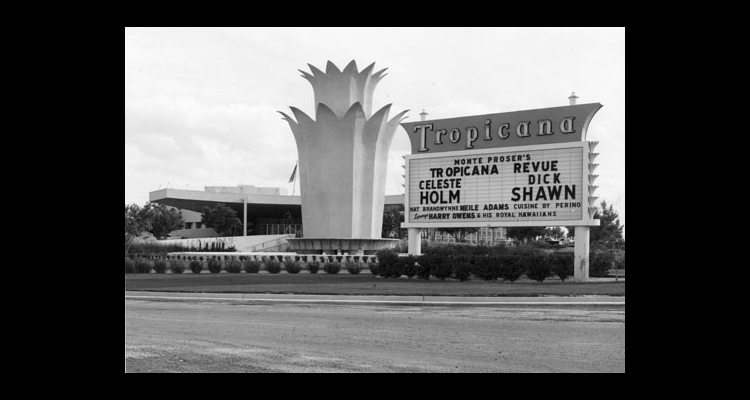Tropicana
The Tropicana Hotel, known for its famous showgirls and past associations with organized crime figures, was the most opulent of the hotel-casinos built during the resort-building boom on the Las Vegas Strip during the dozen years following World War II.
Its founder was Ben Jaffe, partner and operator of the Fontainebleau Hotel in Miami Beach, Florida, who purchased forty acres on the southern end of the Strip in 1955. Jaffe intended to fashion a hotel styled after the then-flourishing Caribbean resorts of Havana, Cuba. He hired an architect and builder from Miami and agreed to lease the casino portion of the resort to gambler Phil Kastel of New Orleans.
But the Stardust hotel was also under construction in the mid-1950s, and Jaffe soon found himself having trouble hiring workers, and short of cash as well. To raise needed funds to complete the Tropicana, he was forced to sell his holdings in the Fontainebleau for $5 million.
His tropics-inspired resort opened on April 4, 1957. But less than a month later, allegations about hidden ownership in the Tropicana by organized crime members made national headlines. After mob figure Frank Costello was shot and wounded in New York, police recovered from him a piece of paper listing cash amounts from the Tropicana's casino that were to be distributed to reputed underworld leaders. The turmoil forced Nevada's Gaming Control Board to deny Kastel's request for a casino license.
To restore the new resort's reputation, Jaffe persuaded long-time Las Vegas casino operator J. Kell Houssels to oversee the Tropicana. Houssels, who bought a six percent interest in the Tropicana, was the respected owner of casinos in downtown Las Vegas, including the El Cortez and Las Vegas Club, and the off-Strip Showboat hotel.
After a difficult couple of years, Houssels turned the Tropicana into a successful casino resort, with the assistance of hotel manager Robert Cannon, entertainment chief Lou Walters, and New York chef Martin Appelt. Houssels bought out Jaffe's share in the hotel-casino business in 1959, but Jaffe retained ownership of the land it was built on. Walters booked name entertainers for the hotel. Houssels's son, attorney J. Kell Houssels, Jr., guided the importation, from Paris, France, of the Folies Bergere stage show, featuring feathered showgirls, which would remain at the hotel for decades.
In 1970, the Houssels and their partners sold the Tropicana to Trans-Texas Airways, which in turn sold it to Deil Gustafson, an investor from Minnesota, only a year later. But in 1974, state gaming officials learned that the hotel, under Gustafson's company, Hotel Conquistador Inc., had lent money for gambling to known mobsters from Detroit. Gustafson was required to sell a controlling interest in the hotel. The majority owner then became Mitzi Stauffer Briggs, the wealthy niece of a former chemical company owner. Briggs invested in the construction of a twenty-two-story hotel tower.
Another crop of investors, called the Associates of the Tropicana, joined Gustafson and Briggs in 1975. Representing the investors was Joe Agosto, who was appointed head of the Folies Bergere show and later ran the hotel. But Nevada officials found out later that Agosto was secretly sending cash from the casino to organized crime chief Joseph Aiuppa of Chicago and other mobsters in Kansas City and Milwaukee.
The FBI, suspecting mob involvement at the Tropicana, set up a broad investigation, known as Operation Strawman, with wiretaps on the phones of reputed mobsters and their associates in Kansas City. From the evidence collected by taps and other eavesdropping in the late 1970s, the FBI discovered a conspiracy to skim money from the Tropicana's casino.
In 1981, a grand jury in Kansas City indicted Agosto, Kansas City mob boss Nick Civella, Civella's brother Carl Civella, mob member Carl DeLuna, and Carl Thomas, the Las Vegan who had directed the illegal skimming of cash at the Tropicana with two others. The defendants were convicted in 1983. Gustafson was convicted in a separate case that involved check fraud at the Tropicana.
The Nevada Gaming Commission revoked the gaming licenses held by Briggs and Gustafson. But the Tropicana kept growing. In 1979, the hotel added the 600-room Tiffany Tower. The Ramada Inn hotel chain would acquire the Tropicana, leasing it from Jaffe's family, which remained its landlord. In 1985, Ramada started a major improvement project called "The Island of Las Vegas" featuring a five-acre water park and a second twenty-two-story hotel tower.
In 1989, Ramada formed a new company, Aztar Corporation, to operate the Tropicana along with Tropicana brand hotel-casinos in Atlantic City, New Jersey, and Laughlin, Nevada. The Jaffe family held the lease on the hotel until 2002, when Aztar paid $117 million for the land. A year later, Aztar said it would spend $500 million on renovations and increase its guest room supply from 1,800 to 3,370.
But the project never got off the ground. The thirty-four-acre Tropicana property changed hands again in 2006, when Aztar agreed to be acquired by the Columbia Sussex Corporation, owner of the Westin Hotel chain, for $2.8 billion.
Article Locations
Related Articles
None at this time.

